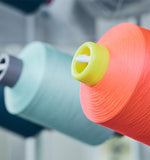
Index
How do compression stockings work?
The pressure that compression stockings put on your legs helps your blood vessels work better. The veins get a boost, thanks to the pressure, that pushes the blood back towards your heart. In this way, 'old', oxygen-poor blood is drained faster from the (lower) legs, making way for 'new' oxygen-rich blood.
New, oxygen-rich blood ensures that muscles are less likely to be damaged during exercise. Which means injuries are prevented. In addition, fatigue and pain in the legs are also prevented in this way.
Swelling in the feet and lower legs is also often caused by fluid retention. Thanks to compression stockings, this moisture is also more easily drained.
Below is a brief explanation of how compression stockings work during the edition of EditieNL about STOX Energy Socks:
Are compression stockings only available on prescription?
No. Compression stockings are not only available by prescription. However, the doctor can prescribe these stockings. In this case, the compression stockings may be paid for by the insurance.
Do my compression stockings fit properly?
Compression stockings are essential for the health of your legs. If they don't fit properly, it can be a big problem to keep your legs healthy. Fit is such an important part of wearing compression stockings that you always have to wonder how they fit. The following five simple ways show whether your compression stockings are right or wrong.
- My compression stockings are painful to use
- Your compression stockings should never be painful to wear. If they hurt, it's a sign you're wearing a size that's too small or too much compression. Check your size by measuring your legs again. Check out the size charts to make sure your size fits your legs. Then check whether the compression level of your stockings is correct. Talk to your doctor about the pressure class you should wear. Also determine where the pain is coming from. If your toes hurt, consider wearing an open-toe compression stocking. If an area hurts behind your knee, make sure your stockings don't contract behind your knee.
- My compression stockings slide down my leg
- If your compression stockings slide down, check that the size is not too big. Sometimes, as the swelling in your leg subsides, the compression stockings will loosen and you will need to get a different size. If you wear the compression stockings for more than 5 to 6 months, it may be time to buy a new pair. Compression stockings wear out over time. To get the right compression on your legs, it is important to always wear compression stockings that have not lost their elasticity.
- My compression stockings are contracting
- Compression stockings should never constrict when you wear them. This is an indication that they are too long for you. If your legs are short and you're wearing a full-length compression stocking, you'll notice extra material when you pull it all the way up. This bundling allows the material to roll and form a tourniquet on your leg.
- Even though I wear my compression stockings, my legs still swell
- If your compression stockings don't control leg swelling, you may not be wearing the right size or compression level. If you have a size that is too big for you, your stocking may not be compressed enough. Please check your size to make sure your measurements are still within the size range. Check your prescription or ask your doctor if the level of compression is right for you.
- I can't even put on my compression stockings
- If you try to put on a compression stocking and it doesn't even go over the foot, the compression stocking may be too small for you. Check the size on the stocking and check your measurements.
How do I wear compression stockings?
It can be difficult to put on a pair of compression stockings at first. However, with a little practice, you'll find what works for you. Here are some tips:
Before you put them on
- Wash new stockings by hand after purchase. This makes them more flexible and easier to put on. Consider buying a second pair if you can afford it. That way you have one clean pair to wear while you wash the others.
- Apply a bandage to an open wound before putting on the compression stockings.
- Keep your stockings near the bed so that you can put them on when you first get up.
To put them on
- Do it early in the morning, when your legs are the least swollen.
- Sit on a chair with a backrest. This will give you something to lean on when you put the stockings on.
- Hold the top of the stocking with one hand. Then grab the stocking with the other hand and push your arm all the way in until you can reach the end and grab your toe.
- Once you have your toe firmly in place, pull your hand back through the stocking, turn it over and leave your fingertips at the top of the stocking.
- Place your toes in the top of the stocking and gently roll over the heel. Then use your fingertips or palms to slowly roll the stocking and push it all the way up.
- Be careful not to pull on the top of the sock as it may tear.
What is the difference between support stockings and compression stockings?
Both support stockings and compression stockings work on the same principle: they support the leg veins in draining the blood, because the blood has to be transported from the feet to the heart against gravity. Compression stockings exert pressure on the legs, this effect gradually decreases as you get closer to the knees. The strongest pressure is applied in the ankle area. Support stockings and compression stockings significantly improve blood circulation by constricting the veins and allowing the blood to flow back faster.
The difference between compression stockings and support stockings is mainly between the pressure classes. Compression stockings are generally made with higher compression than compression stockings. In essence, support and compression stockings are two words for the same product, however, the higher compression stockings are often referred to as support stockings. Compression stockings are therefore often used by people with a medical condition, such as varicose veins. Compression stockings are used by people with milder complaints or for preventive reasons.
Can compression stockings be harmful?
In principle, compression is harmless. In the medical world, however, there is discussion about certain situations in which compression stockings can be dangerous. If you fall under the following situations, it is better to consult with your doctor before purchasing compression stockings.
- Ischemia: This is a situation where the blood supply in extremities is reduced because there is a blockage in the arteries.
- Peripheral neuropathy: there is damage to the nerves in the hands, arms, feet and legs.
- Heart failure
- Cellulitis: an infection deep in the skin that leads to an accumulation of fluid.
- Allergies: Some people are allergic to the materials that make up compression garments. Skin reactions do occur - sometimes these can be resolved by using a different brand or type.
Why do my compression stockings slip down?
Compression stockings that are not tight can be the cause of many different factors. Perhaps the following mini-guide can solve your problem.
- Have you washed the compression stockings?
- They should be washed after each wear to remove dirt, sweat, dead skin and body oils. If you wear compression stockings that have not been washed, the elasticity in the stocking may be somewhat reduced. So make sure you wash the stocking properly.
- Check the size
- Not every compression stocking fits every person's legs perfectly. Sometimes you have to take a measurement here and there to get the best fitting compression stocking. Check your measurements. You may not be wearing the right size.
- Weight gain or weight loss? More or less swelling?
- Compression stockings don't change as fast as your body. Have your leg measured from time to time to ensure that your compression stocking is still the right size for you. When people wear compression stockings for the first time, their legs are swollen. After prolonged use, the legs swell less and the compression stockings can therefore fit less well.
- Thin thighs? Fat knees? Don't worry, everyone has different legs
- Some people have thin thighs and high compression stockings that unroll easily. People with softer skin often have problems with their stockings slipping. In both situations, people find it annoying and sometimes uncomfortable when the compression stockings roll down.
How to maintain compression stockings and how long do they last?
Your stockings come with washing and drying instructions. These instructions will help your stockings last longer. You will need new stockings about every 6 months.











